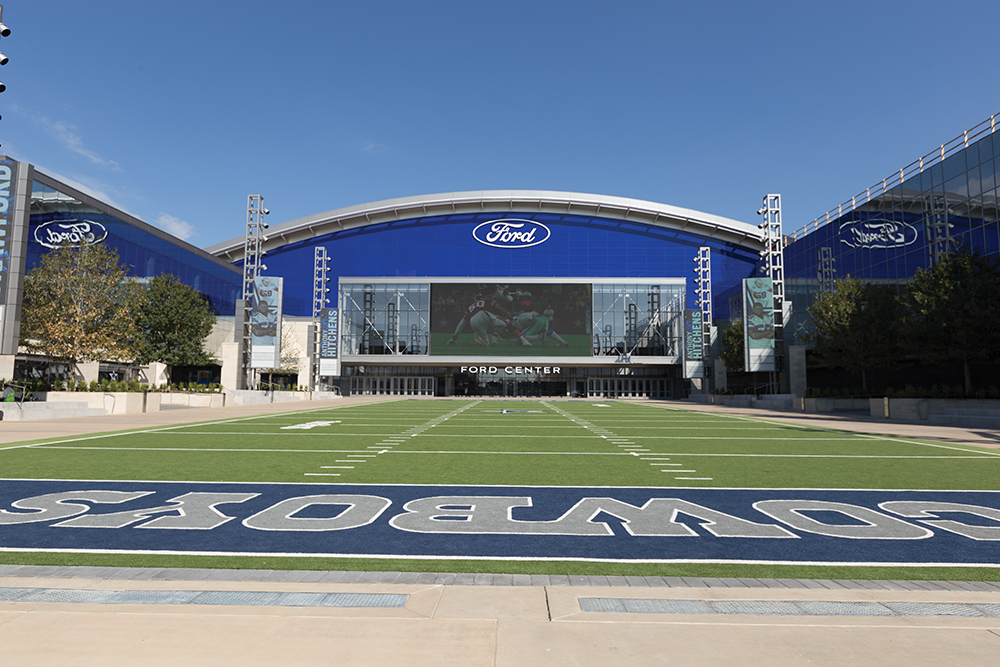When the City of Frisco and the Dallas Cowboys announced in August the Irving-based National Football League club would relocate its team headquarters to Frisco by fall 2016, it was a big day for everyone involved.
The 25-year agreement between the Cowboys, the City of Frisco and the Frisco Independent School District calls for America’s Team to relocate its headquarters and practice facility to a 91-acre tract of land on the northwest corner of Warren Parkway and the Dallas North Tollway by 2016. The agreement stipulates the Cowboys will hold at least one week of their annual training camp in Frisco, an event that attracts a multitude of fans.
However, the Cowboys’ new headquarters will cover just five acres of that area with the rest being a mixed-use development that will include a 12,000-seat indoor stadium that schools from Frisco ISD will play in -- plus hotels, restaurants, office space and retail space.
The project, which includes a public investment by the City of Frisco and Frisco ISD of $115 million, is expected to deliver $23.4 billion of economic impact through 2042, create 4,500 new jobs by 2026 while delivering an estimated $1.26 billion of tax revenue to various entities.
“Well, I think it’s awesome,” Jim Gandy, president of the Frisco Economic Development Corporation (EDC), said. “The opportunity to bring the world corporate headquarters and training facility of the Dallas Cowboys to Frisco is an incredible achievement for our city. It’s not often you get the chance to locate a company of that stature and a company that has that type of brand recognized worldwide. It will definitely bring a tremendous amount of economic benefits to our city.”
One impressive dimension of this deal is how quickly it all came together. According to Mr. Gandy, just more than 90 days passed between when the partnership was first proposed until the signing of the final papers. The idea came from two principle members of REX Real Estate, a Frisco-based investment real estate company. It was one of those principles, Matthew Kiran, who first pitched the idea to Mr. Gandy.
“He said ‘Jim, I’d like to come by and talk to you about a project. I think you’re going to be interested. So can I come by and talk to you today at four o’clock?’ I said yes. He came by and introduced the project. For me and the Frisco Economic Development Corporation, that’s when it started, from that meeting,” Mr. Gandy said.
In April, the proposal was first brought to Cowboys Chief Operating Officer Stephen Jones. “We had some people that worked with both the City of Frisco as well as our family that said, ‘hey, wouldn’t this be a good idea?’ I think they kind of nodded their head yes and we did too, and we went in a room trying to figure something out,” Mr. Jones said.
After the proposal was tweaked, it was then presented to Stephen Jones’ father, Cowboys Owner Jerry Jones, who signed off on the project on June 20. Six days later, Stephen Jones and Frisco City Manager George Purefoy made it official with a handshake and the agreement was finalized in early August.
Mr. Gandy feels one reason the deal was completed so quickly was due to the high level of cooperation between the city, FISD and the Frisco EDC and Community Development Corporation. That high-level cooperation also impressed Stephen Jones, who lauded the efforts of Frisco Mayor Maher Maso, Mr. Gandy and Mr. Purefoy in particular for their respective roles in helping to ensure that the partnership came to fruition. “They were just a pleasure to work with. They know how to make a deal,” Mr. Jones said. “They obviously did what was in the best interest of Frisco and their taxpayers and what was in the best interest for the business of Frisco.”
 Similar projects in other cities have been met with a considerable amount of public opposition, but that was not the case with this agreement according to Frisco’s current mayor, who effectively quelled concerns residents had about this project.
Similar projects in other cities have been met with a considerable amount of public opposition, but that was not the case with this agreement according to Frisco’s current mayor, who effectively quelled concerns residents had about this project.
“Very minimal,” was how Mayor Maso termed the opposition to this project. “When I had a chance to speak with many of those individuals and explain the financial side of it, I’m not sure they were really opposed to it anymore. The first knee-jerk reaction was related to how much is this going to cost us in taxes? And when we explained that financial picture and their return on that investment, most of that went away.”
Perhaps the biggest selling point of this partnership between one of the most recognizable brands in the sports world and the City of Frisco is that this relationship is a highly beneficial arrangement for both sides. For the Cowboys, that means they get to have a considerable footprint in Collin County, an area Stephen Jones feels they went away from when they decided to build AT&T Stadium in Arlington in 2007.
Mr. Jones also likes the fact that the Cowboys will now be part of a burgeoning Frisco sports landscape that is home to FC Dallas, the Dallas Stars and the Frisco Roughriders, the Double-A affiliate of the Texas Rangers, and the Texas Legends, the NBA D-League affiliate of the Dallas Mavericks.
“When we moved to Arlington with the stadium, we moved away from Collin County and North Dallas, if you will, in that growth corridor. And we think by putting our practice facility there and really putting our flagpole there, if you will, we’ll continue to be able to touch fans that want to come out and be a Cowboy and be a part of our fan base,” Mr. Jones said. “To get to be a part of that group, we’re certainly honored. At the same time, we want to do our part. We want to pull our weight in this. We think we will. We think it will make the Frisco community even stronger and better when it comes to the lifestyle and culture that they want to have in Frisco.”
Besides the city getting the added prestige of now being home to the Cowboys’ headquarters, Frisco will also benefit from now having a third facility, joining Frisco Memorial Stadium and Toyota Stadium, where high school teams can play in the new 12,500-seat indoor stadium that will be part of this development.
“The school district was already talking about building a third football stadium because of the continued growth of our school district,” Mr. Gandy said. “The opportunity for them to participate in this stadium will be approximately a $30-million investment with the benefit of not having to pay annual maintenance of a football stadium, which will save the school district about $250,000 a year.”
Frisco ISD Athletic Director David Kuykendall agrees this project will definitely benefit students in the district. “This is an unprecedented opportunity for our students to walk and play on the same fields as professional football players,” Mr. Kuykendall said. “The memories that our students will make and take with them will last forever. It may even motivate some to move on to the next level.”
Steve Hunt is a Frisco-based freelance writer.







